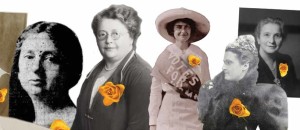Lilith staff
Before Women’s Choices and Votes Counted
Cheer for Jewish activists who labored for women’s suffrage 99 years ago.
Ninety-nine years ago—August 18, 1920—women won the right to vote in the United States. Many of these suffragist foremothers were Jewish women, and though some here may have escaped your notice (visit jwa.org for more images and bios), they have a crucial message for you today—no matter the country where you vote: Do not squander this right!
Milestones are simply reminders of the work yet to be done; without a clear-eyed view to the future they’re mere sentiment. Find out the issues affecting women locally and globally—reproductive justice, education, commerce, legislative power— and make your opinions become reality at the polls. Celebrate this centenary anniversary by making sure that voting rights are not trammeled, that all genders have access to the polls, and, especially, that you keep women’s issues (that is, human issues) in the forefront of your consciousness as you mark your ballot.

Photo Collage by Lindsay Barnett

Photo collage by Lindsay Barnett
From left: Suffragist Anita Pollitzer, Henrietta “Netta” Franklin, Rosika Schwimmer, Rebecca Hourwich Reyher, Rosalie Whitney, Rosa Manus, Gertrude Weil, Maud Nathan, and Mary Belle Grossman. Suffragists wore yellow roses at the Tennessee General Assembly when that state became the 36th state to ratify the 19th amendment; red roses were worn by opponents to women’s right to vote.
REBECCA HOURWICH REYHER (1897–1987)
Reyher served the suffrage movement as a member of the National Women’s Party in Boston and New York. Working as a journalist, she supported her entire family. She was also an advocate for Jewish refugees in the U.S., as well as an international activist and scholar for the peace movements and education access for women.
HENRIETTA “NETTA” FRANKLIN (1866–1964)
A member of the small but mighty Jewish subgroup of the suffrage movement in Britain, Franklin served as president of the British National Union of Women’s Suffrage Societies in 1916 and 1917. She believed deeply in the power of education and the professional advancement of women. For Franklin and her peers, this work for women’s suffrage fostered a sense of belonging in British society, especially in the context of a predominantly Christian-led social movement.
MARY BELLE GROSSMAN (1879–1977)
One of the first women accepted into the American Bar Association, in 1918, Grossman lived and worked as a political activist and judge in Cleveland. “I studied law in self-defense because all the young men were getting promotions faster than I.” A fierce advocate for women and families, Grossman was described in the Cleveland Press: “Militant feminist has been bad news to wife beaters, gamblers, and persons charged with morals offenses.”
ROSA MANUS (1881–1943)
Manus worked for women’s rights and pacifism in pre-WWII Western Europe. She worked for the Dutch branch of the International Women’s Suffrage Alliance and for the Women’s Disarmament Committee of International Organizations. Despite these credentials, as a leftist and a Jew she faced contempt from the suffrage movements. After multiple arrests and deportations because she was Jewish and an antifascist activist, she was taken to Auschwitz.
MAUD NATHAN (1862–1946)
Born to a distinguished New York Sephardic family, Nathan defied tradition as she gained momentum as an activist for women’s suffrage. She joined the suffrage movement after the death of her daughter and was especially active in matters of labor and the workplace. She served on the New York Consumers League, the Woman’s Municipal League of New York, and various other organizations concerned with social reform and political activism. In 1897 she was the first woman invited to speak at the Sephardic synagogue Shearith Israel, where she shared her views on the need or religious and racial tolerance. She received support from her husband and peers, but her activism created conflict within her family, especially with her sister, Annie Nathan Meyer, who founded Barnard College but did not support women’s right to vote.
ANITA POLLITZER (1894–1975)
Political activist and advocate for the arts, Pollitzer held a unique role in the suffrage movement. She garnered attention in 1917 after her arrest for picketing the Woodrow Wilson White House as a Silent Sentinel. After earning a degree in arts and education, she organized for the National Woman’s Party: in 1920 she (and his mother) convinced legislator Harry T. Burn of Tennessee to cast the deciding vote for the 19th amendment.
ROSIKA SCHWIMMER (1877–1948)
Schwimmer began her work as an advocate for women’s rights in the workplace. As a young woman, she approached these issues at home in Hungary. She later spoke at the International Women’s Congress in Berlin, and joined the International Woman Suffrage Alliance. Once World War I began, she shifted her focus to help lead the international pacifist movement, but continued to incorporate feminist and other radical political messages into her work for world peace. She remained committed to these causes even as antisemitic and misogynistic political forces threatened her career.
GERTRUDE WEIL (1879–1971)
Weil worked for women’s suffrage in her home state of North Carolina by cofounding the Goldsboro Equal Suffrage Association in 1914. She later served as an officer in the North Carolina Equal Suffrage League in 1917 and in 1919 she became president of the organization. “Women breathed the same air, got the same education; it was ridiculous, spending so much energy and elocution on something rightfully theirs.”
ROSALIE WHITNEY (1873–1939)
In 1901, Whitney became the first woman to serve as the chief attorney at the New York Legal Aid Society. In 1917, she joined the Brooklyn Woman’s Suffrage Party and continued on to serve as New York congressional chair in the Woman’s Federal Equality Association. She also spoke for the National American Woman Suffrage Association at the House of Representatives suffrage amendment hearing in 1918. Born Jewish, after her marriage to Travis Harvard Whitney in 1875, she and he converted to Protestantism (though the reason is not recorded).
 Please wait...
Please wait...